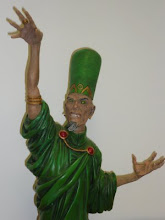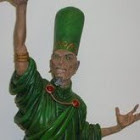 Wonderful science fiction that full advantage of comics unlimited budget and special effects to throw off extraordinary images and ideas on every page. Old man John Prophet, the long term enemy of the Earth Empire has been restored to life at the same time as the Earth Empire itself. He starts on the journey to find those of his allies who may still be alive and willing to return to the fight, he finds some and encounters new ones and the first major assault by the Empire is launched.
Wonderful science fiction that full advantage of comics unlimited budget and special effects to throw off extraordinary images and ideas on every page. Old man John Prophet, the long term enemy of the Earth Empire has been restored to life at the same time as the Earth Empire itself. He starts on the journey to find those of his allies who may still be alive and willing to return to the fight, he finds some and encounters new ones and the first major assault by the Empire is launched.The storylines is severely simple, a man looking for others to join his struggle, this leaves all the room for the astounding interstellar context and the fireworks display of ideas and extraordinary detail to come to the fore without having to support a plot.
The sheer inventiveness of the writers and artists is staggering, each page is bristling with ideas that fill out the extraordinary vision of a crowded space filled with the remnants of a previous war. The scope of the ideas is captured in a great double page spread showing the dismembered remains of a giant, his remains serving as the basis for a thriving mining industry into his flesh and active trading post, with an entity delaying becoming a planet to wait by his companion.
The most plot significant section of the book follows how John Prophet, cloned servant of the Earth Empire, became its most persistent enemy. The gorgeous art by Farel Dalrymple is one of the highlights on the book, the story and the art work superbly together in a unified way.
Elsewhere the art transition is so severe that I thought the book had some pages missing, it took a bit a re-reading and careful attention to pick up the story threads from one chapter to another.
One of the strongest aspects to the story is the lack of explanation that is provided, the context is what it is, there is no time spend proving any more that enough detail to identify the components before the reader is moved on to the next starburst of ideas. This works really well for a huge space opera like this story, the reader is taken along for the ride by the relentless push of ideas as the sheer scope of the story and the enormous story possibilities are unfolded in front f them.
The glorious confidence of the writers and artists in their work that they can be sure that the reader will follow along frees them up to pursue the project to astonishing directions and still find room for a toilet joke. Ambitious science fiction is delivered in all its glory in this great comic.








